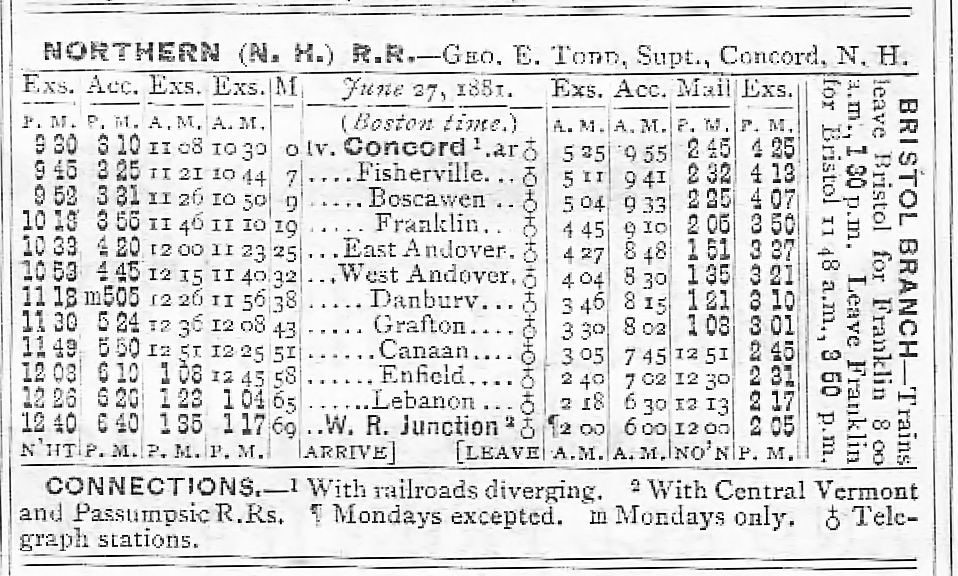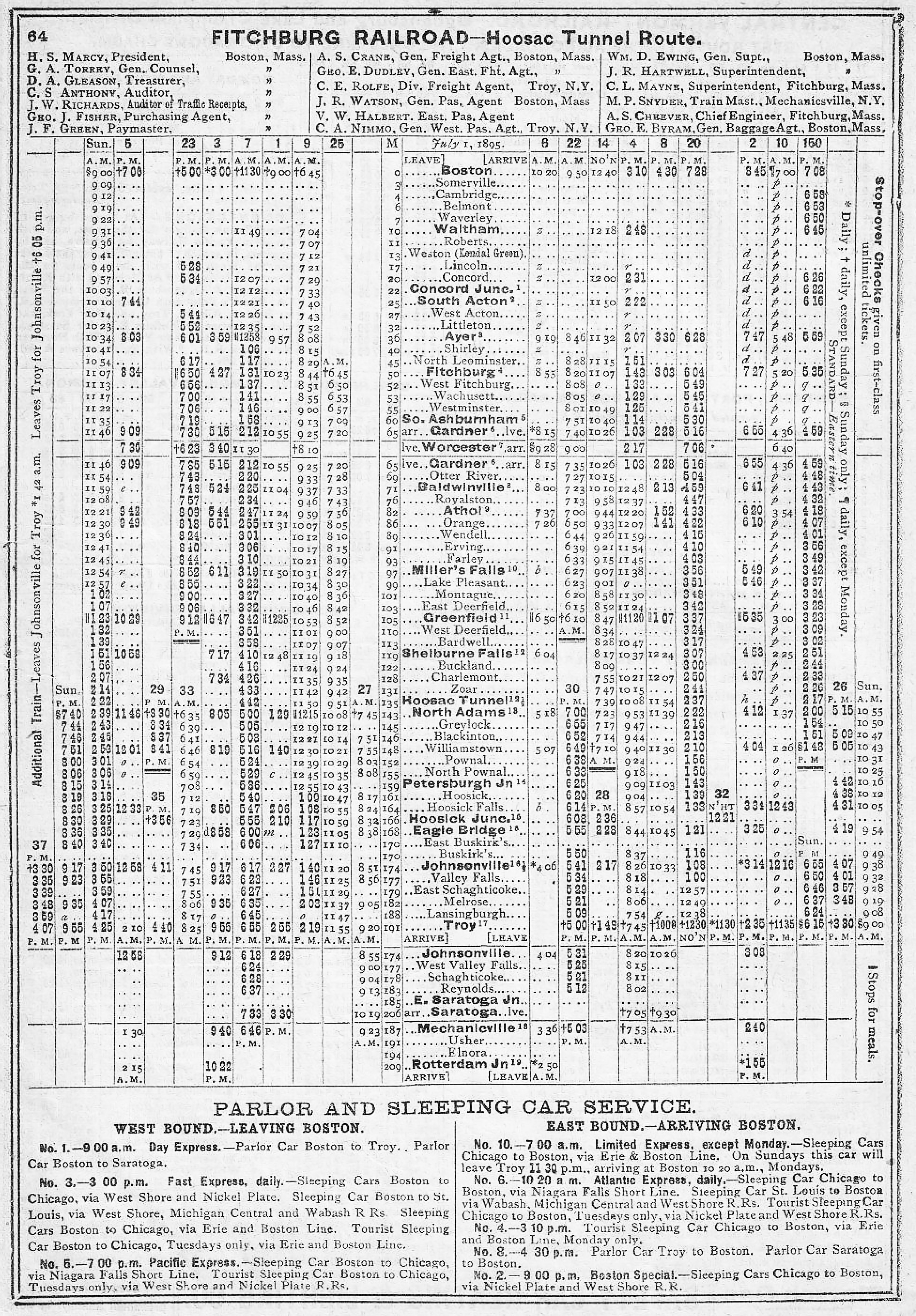Northern Railroad (NH): A Future B&M Subsidiary
Published: February 11, 2025
By: Adam Burns
The Northern Railroad, once a vital artery in the development of New Hampshire and northern New England, is a testament to the transformative power of railroads in the 19th century.
From its inception to its eventual decline, the Northern Railroad played a pivotal role in shaping the economic and social landscape of the region.
It was eventually leased by the growing Boston & Maine in 1889 and played an important role within this large New England railroad's network, offering a direct connection to the Central Vermont Railway at White River Junction.
The route thrived until the post-World War II era; the final passenger service ceased on January 3, 1965. The line remained largely intact until the Guilford Transportation Industries era began, resulting in the abandonment of a 59-mile section from Boscawen to Lebanon in 1991.
After the early 1970s the line saw little use and was abandoned in stages over the years with the last remaining section abandoned in 2016. Today, part of the corridor is a rail trail.
Timetable (1881)
Early Years
Incorporated initially as a subsidiary of the Boston & Lowell Railroad in 1884, the line ran from Concord to White River Junction, Vermont, where it linked with the Central Vermont Railway. It received its charter in 1844 from the New Hampshire state legislature with a mandate to construct a railway extending from Concord to a point on the Connecticut River.
Following its establishment in July, the railroad initiated groundbreaking activities on October 8, 1845. The initial segment of the line, spanning from Concord to Franklin, commenced operations on December 28, 1846, under the management of the Concord Railroad. By September 1, 1847, the Northern Railroad assumed control of the route extending to Canaan, and by November 17, the line had reached its ultimate terminus in West Lebanon. In June 1848, an extension was constructed to White River Junction, situated across the Connecticut River in Vermont, thereby connecting with both the Vermont Central Railroad and the Connecticut and Passumpsic Rivers Railroad.
At the ribbon-cutting ceremony in Lebanon in 1847, Daniel Webster delivered a speech, exclaiming, "It is altogether new. The world has seen nothing like it before." Notably absent from the 1,200 attendees at the inauguration of this "steam highway" were members of the Shaker community from nearby Enfield. During the railroad's construction, the Shakers had negotiated with the railroad to alter the proposed route to the northern side of Mascoma Lake, thus distancing it from their colony. A stock purchase solidified this agreement.
In July 1846, while the Northern Railroad was still under construction, the Franklin and Bristol Railroad Company received a charter to build a 13-mile line from Franklin on the Northern's main line to Bristol. Prior to commencing operations on July 2, 1848, the company was leased to the Northern Railroad for a term of 100 years, effective from April that year. Due to limited prospects for financial return from building a railway to what were described as "waterfalls now waste and desolate," the Franklin and Bristol was consolidated with the Northern Railroad on January 31, following an act by the New Hampshire Legislature, becoming known as its Bristol Branch.
Construction of the Northern Railroad progressed swiftly; by December 28, 1846, it had expanded to Franklin, and by November 17, 1847, it had reached Lebanon. Within a few months, work on the bridge over the Connecticut River was completed, finalizing the route to White River Junction. The Northern Railroad ultimately spanned approximately 70 miles.
During this period, the company also expanded through the acquisition of its sole branch by leasing, and subsequently assuming control of, the Franklin & Bristol in 1849. This small network connected Franklin to Bristol, New Hampshire.
Bruce Heald's book, "A History Of The Boston & Maine Railroad," notes that on July 24, 1889, the New Hampshire General Court authorized the Boston & Maine to formally lease the Northern Railroad.
Beginnings
The story of the Northern Railroad begins in the early 19th century, a period when the United States was rapidly expanding its transportation infrastructure to support burgeoning industries and populations. The idea of building a railroad in northern New Hampshire was sparked by the industrial and economic momentum across New England. In 1844, the Northern Railroad was officially chartered with the purpose of connecting Concord, New Hampshire, to the more remote and rugged regions of the north.
Capitalizing on the era's railway boom, the charter's proponents saw the railroad as a means to stimulate economic activity, particularly in lumber and agriculture, and to provide a reliable transportation link between rural communities and larger markets. With financial backing from local investors and the support of vital stakeholders, the construction of the railroad began.
Construction and Expansion
Construction commenced soon after the charter was granted. Under the engineering expertise of individuals such as George Stark, the railroad started its ambitious task of laying down tracks through difficult and varied terrain. By 1847, the railroad reached Lebanon, a significant milestone that fueled further expansion. The route overcame natural obstacles such as rivers and mountains, requiring innovative solutions and the dedication of countless laborers.
In 1851, the Northern Railroad achieved a major triumph by extending its line to White River Junction, Vermont. This connection opened up new possibilities, linking the railroad with the larger rail networks of western New England and beyond. The new accessibility traversed the Connecticut River, fostering trade and travel between communities on both sides of the state line.
Decline
Throughout the 20th century, the Northern Railroad continued to face diminished demand as automobiles and highways became the preferred means of transport for both passengers and freight.
By mid-century, sections of the railroad were gradually abandoned or repurposed, marking the end of an era. The last regular passenger service ran in the 1950s, and freight operations eventually ceased altogether.
Following 1973, usage of the line was sporadic, with one significant event being the passage of the Freedom Train in 1975. The line saw its final brief utilization in 1982 due to a derailment in Brattleboro, which obstructed the Boston and Maine route along the Connecticut River.
After the line was officially abandoned in 1992 by the Guilford Rail System—the successor to the Boston and Maine—New Hampshire state acquired 59 miles of the corridor in 1995, extending from Boscawen to Mile 140.00 in Lebanon, to establish the Northern Rail Trail.
In 1998, the state further purchased the remaining two miles up to White River Junction, which included the expansive Westboro Rail Yard, later leased to Claremont Concord Railroad and a local enterprise. In September 2016, a notice of intent was filed with the Surface Transportation Board to abandon the last 6.63 miles of the Northern Railroad main line stretching from Concord to Boscawen.
Today, much of the former Northern Railroad corridor has been transformed into recreational trails, such as the Northern Rail Trail, preserving its historic path for new generations to enjoy. These trails offer scenic vistas and a tangible connection to the region's past, serving as a testament to the railroad's enduring impact on New Hampshire.
Legacy
In conclusion, the Northern Railroad played an instrumental role in shaping the history and development of New Hampshire. Its journey from a pioneering transportation project to a cherished historical landmark reflects broader themes of progress, adaptation, and remembrance. The legacy of the Northern Railroad lives on, echoing the transformative power of railroads in the American story.
Recent Articles
-
Northern Railroad (NH): A Future B&M Subsidiary
Feb 11, 25 11:32 PM
The Northern Railroad was a small, 19th century system that connected Concord and White River Junction. It was acquired by the Boston & Maine in 1889. -
Fitchburg Railroad: "The Hoosac Tunnel Route"
Feb 11, 25 10:46 PM
The Fitchburg Railroad dated back to 1840 and eventually opend a western extension to eastern New York. It opened the Hoosac Tunnel and became an important B&M subsidiary. -
Boston & Lowell Railroad: A Notable B&M Predecessor
Feb 11, 25 09:48 PM
The Boston & Lowell was one of New England's earliest systems, formed in 1835. A longtime Boston & Maine rival it was later acquired by the B&M in 1887.



